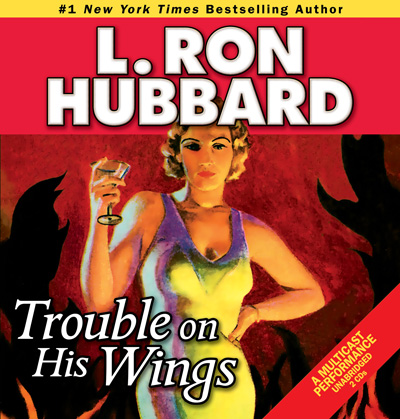Flying into action, daredevil photojournalist Johnny Brice is always looking for trouble … and more often than not, finding it. But he doesn’t know what real trouble is until he rescues the beautiful woman he calls Jinx from a sinking ship.
Get the picture? Well, Johnny always does. The problem is, with Jinx now in the picture, all his photo-scoops are going down the drain—losing his film to water, fire, or war. And it all comes to a head-on assignment in China, when the Japanese shoot his plane down and take Jinx and Johnny prisoner.
Their lives at risk, it’s time for Johnny to get the real story about the lady. Is she really a jinx … or something even more sinister? In an adventure full of surprising discoveries, getting at the truth leads to the most shocking twist of all.
Performers: R.F. Daley (narrator), Jennifer Aspen, Bob Caso, Jim Meskimen, and Matt Scott.
SAMPLE
ABOUT THE AUTHOR
L. Ron Hubbard had first-hand experience of flying high with Trouble on His Wings. As a young aviator, he loved to tempt danger. One journalist wrote: “The flaming-haired pilot hit the city like a tornado a few years ago. He just dared the ground to come up and hit him.” The knowledge and insight he gained during those flights are clearly evident in his aerial adventure stories.
Trouble on His Wings Glossary
Stories from the Golden Age reflect the words and expressions used in the 1930s and 1940s, adding unique flavor and authenticity to the tales. While a character’s speech may often reflect regional origins, it also can convey attitudes common in the day. So that readers can better grasp such cultural and historical terms, uncommon words or expressions of the era, the following glossary has been provided.
Albany night boat: one of a large number of river steamers formerly common to the Hudson River and patronized by New York City residents, vacationers and newlyweds.
amphibian: an airplane designed for taking off from and landing on both land and water.
Amur: Amur River, the world’s ninth longest river that forms the border between northeastern China (Manchuria) and the Russian Far East (between Siberia and the Pacific Ocean). It was an area of conflict during the war between China and Japan that began in 1937, and eventually led to World War II in the Pacific.
astern: in a position behind a specified vessel.
ballyhoo: to advertise or publicize noisily or blatantly.
Black Hills: a small isolated mountain range in western South Dakota and extending into Wyoming. The Black Hills are home to the tallest peaks in continental North America east of the Rocky Mountains.
bull: a gross blunder.
bumboat: a boat used in peddling provisions and small wares among vessels lying in port or offshore.
bung starter: a wooden mallet used for tapping on the bung (cork or stopper) to loosen it from a barrel.
cabin job: an airplane that has an enclosed section where passengers can sit or cargo is stored.
castellated clouds: cloud formation named for its tower-like projections that billow upwards from the base of the cloud.
China Clipper: one of three Martin M-130 flying boats designed and built by the Glenn L. Martin Company for Pan American Airways in the 1930s. The planes, called Clippers and named for the swift square-rigged sailing ships of the 1800s, were designed to take off and land on water and possessed long-range flying capabilities. The China Clipper started flying passengers in 1936 from San Francisco to Manila making the 8,050-mile (13,683-km) trip in 60 hours of actual flying time spanning five days with stopovers in Hawaii, Midway Island, Wake Island, Guam and Manila.
Coeur d’Alene: city located in northern Idaho, on the northern shore of the Coeur d’Alene Lake and the western edge of the Coeur d’Alene National Forest. The city is named for the Coeur d’Alene tribe of Native Americans, a name given them by the French traders meaning “heart of awl,” or “sharp-hearted” out of respect for their tough trading practices.
crown fire: a fire that crowns (spreads to the top branches of trees) and can spread at an incredible pace through the top of a forest. Crown fires can be extremely dangerous to all inhabitants underneath, as they may spread faster than they can be outrun, particularly on windy days.
davits: any of various cranelike devices, used singly or in pairs, for supporting, raising and lowering boats, anchors and cargo over a hatchway or side of a ship.
DeVry: manufacturer of 35mm and 16mm movie cameras popular in the 1930s, especially with newsreel cameramen.
flying boat: a seaplane whose main body is a hull adapted for floating.
foredeck: the forward part of a boat’s main deck.
Frisco: San Francisco.
gig: a boat reserved for the use of the captain of a ship.
G-men: government men; agents of the Federal Bureau of Investigation.
gow up: to make sticky or mess something up. From gow, meaning opium or sap; the sticky brown resin harvested from poppies. Used figuratively.
gumbo: soil that turns very sticky and muddy when it becomes wet; found throughout the central US.
gunwale: the upper edge of the side of a boat. Originally a gunwale was a platform where guns were mounted, and was designed to accommodate the additional stresses imposed by the artillery being used.
Han River: a river, about 700 miles long (1,126 km), of east central China flowing generally southeast to the Yangtze River.
Jonah: somebody who brings bad luck.
kite: an airplane.
lampblack: a black pigment made from soot.
Lord Chesterfield: English politician and writer best known for Letters to His Son (1774), which portrays the ideal eighteenth-century gentleman.
man-o’-war: any armed ship of a national navy, usually carrying between 20 and 120 guns.
Medusa: (Greek mythology) monster with live venomous snakes for hair; people who looked at her would turn to stone. A hero, Perseus, was able to kill Medusa, aiming his sword by looking at her reflection in a highly polished shield, and then cutting off her head.
Nakajima: the name for the aircraft produced by the Nakajima Aircraft Company, Japan’s first aircraft manufacturer, founded in 1917.
newshawk: a newspaper reporter, especially one who is energetic and aggressive.
painter: a rope, usually at the bow, for fastening a boat to a ship, stake, etc.
Perseus: (Greek mythology) hero who killed Medusa. The god Hermes and goddess Athena helped him in this brave deed by giving him winged shoes, a magical sword and a polished shield. With the help of these, he swooped down on Medusa from the air, used the shield as a mirror, and cut off her head without looking at her directly—as anyone who looked at her turned to stone.
Rising Sun: Japan; the characters that make up Japan’s name mean “the sun’s origin,” which is why Japan is sometimes identified as the “Land of the Rising Sun.” It is also the military flag of Japan and was used as the ensign of the Imperial Japanese Navy and the war flag of the Imperial Japanese Army until the end of World War II.
Scheherazade: the female narrator of The Arabian Nights, who during one thousand and one adventurous nights saved her life by entertaining her husband, the king, with stories.
sculling oar: a single oar that is moved from side to side at the stern of a boat to propel it forward.
siege guns: heavy guns for siege operations, used to overcome the target with bombardment. (A siege is a military operation in which an army surrounds a fortified place and isolates it while continuing to attack.)
slipped: caused (a descending parachute) to glide in a particular direction by pulling down on suspension lines on the side toward the desired direction so as to spill air out of the opposite side of the canopy.
slipstream: the airstream pushed back by a revolving aircraft propeller.
smeared: smashed.
snap-brim: a felt hat with a dented crown, and the brim turned up in back and down in front.
SS: steamship.
stall: a situation in which an aircraft suddenly dives because the airflow is obstructed and lift is lost. The loss of airflow can be caused by insufficient airspeed or by an excessive angle of an airfoil (part of an aircraft’s surface that provides lift or control) when the aircraft is climbing.
struts: supports for a structure such as an aircraft wing, roof or bridge.
tarmac: airport runway.
tracer: a bullet or shell whose course is made visible by a trail of flames or smoke, used to assist in aiming.
volplaning: gliding toward the earth in an airplane, with no motor power or with the power shut off.











